Today we are homo eroticism aquamaninvestigating two commonly asked questions about gaming laptops: what's the performance like on battery and how long do these laptops last in games? We'll also explore if battery life can be extended in any way; and do less powerful systems last longer? We have some great apples-to-apples data for you, so it should be interesting to learn and have this as a bit of an FAQ for gaming laptop buyers.
The reason we say apples-to-apples is that we have the rare opportunity of testing two essentially identical systems where only the discrete GPU is different. This will let us test how the GPU difference impacts battery life and playability when you are not plugged in to the wall.
Our test bed consists of two Acer Predator Triton 700 systems, both have typical laptop hardware like a Core i7-7700HQ CPU, a 1080p display, and 512GB SSDs. One machine has a GeForce GTX 1060 6GB, while the other has a GeForce GTX 1080 Max-Q.
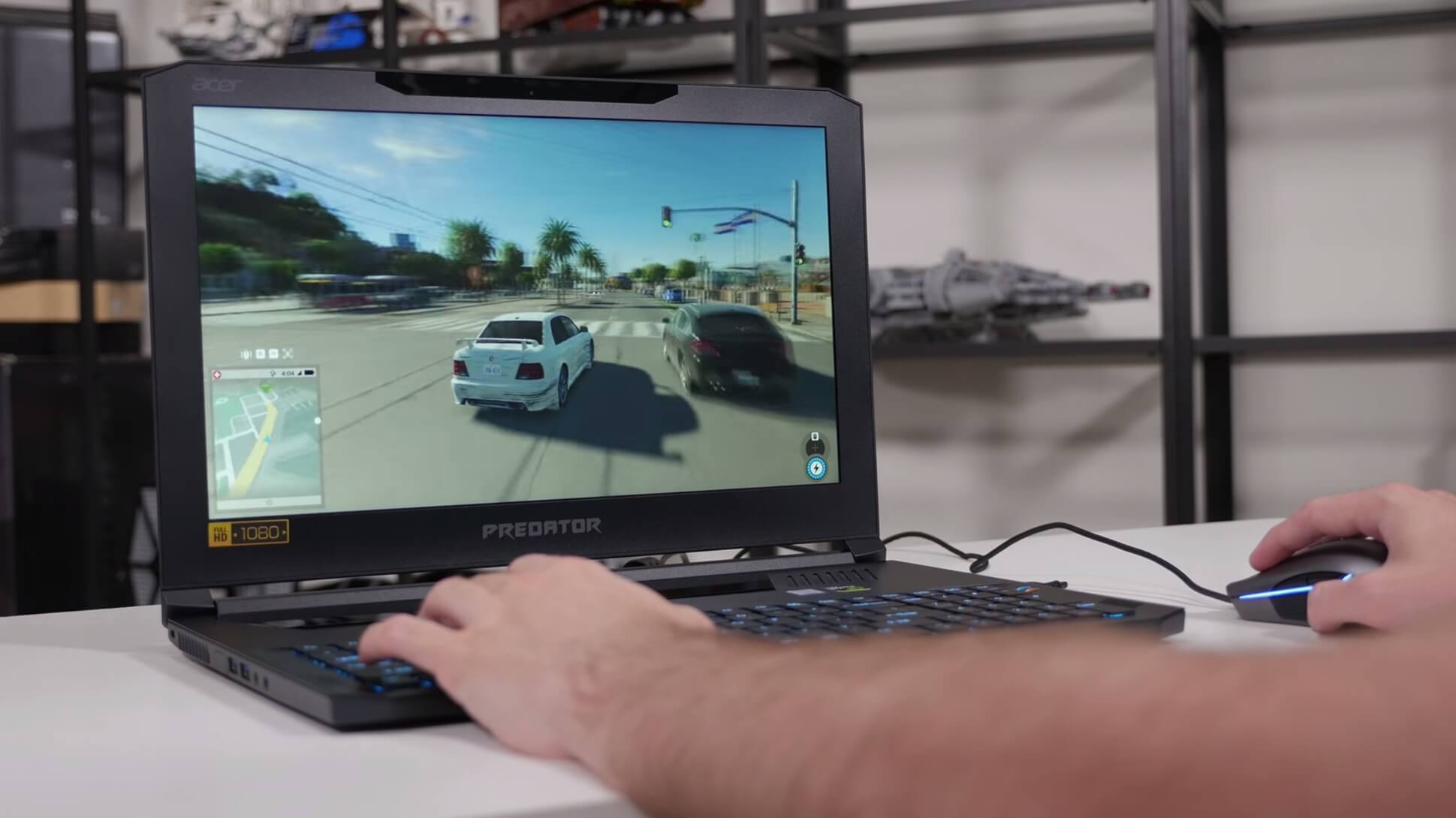
Both use the same cooler and largely the same other hardware. The only other difference is the 1080 Max-Q model has 32GB of RAM instead of 16GB, and a higher refresh 120Hz display with G-Sync. Both systems have batteries approximately 50 Wh in size, which is fairly small for a gaming laptop.
As a reference, the three gaming laptops we recommended in our Best Laptops feature these past holidays had 50 Wh, 62 Wh and 48 Wh sized batteries, in the Asus ROG Zephyrus, Asus ROG GL502VS and Acer Predator Helios 300, respectively. Meaning the Triton 700 we are testing with does have a small battery that is nonetheless not out of the norm for slim gaming laptops.
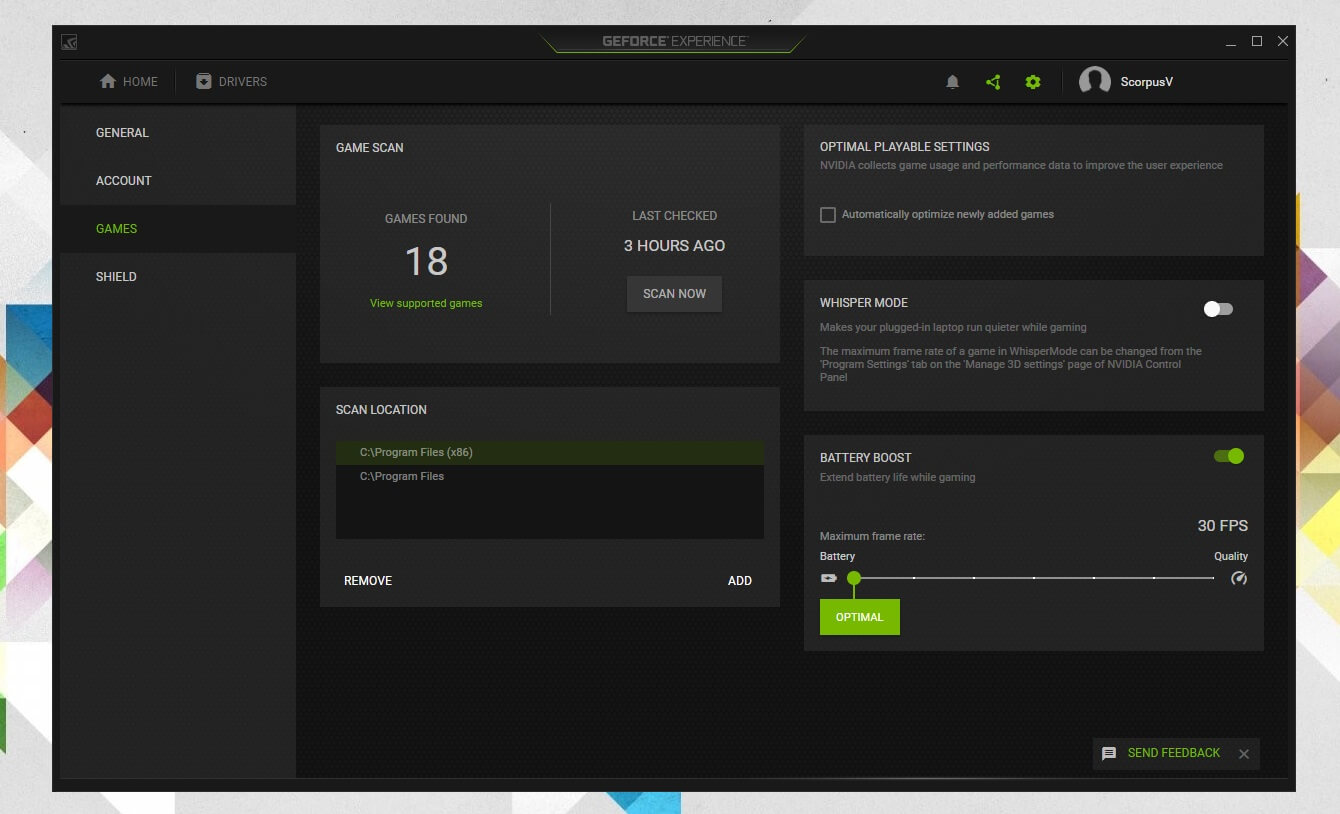
So when gaming on battery there are a couple of different performance modes you can choose from using the GeForce Experience utility. Called Battery Boost, this setting limits the performance of games to a frame rate of your choice between 30 and 60 FPS when enabled.
The idea is that you can cap a game's performance, leading to lower GPU usage and less battery drain for potentially longer gameplay on battery.
But there's one critical thing to note here: even when Battery Boost is disabled, you will never achieve the same level of performance as when plugged in. This is down to simple battery physics: the battery can't provide the 180 to 230 watts that the charger provides, and even if it could, it'd likely run at dangerously hot levels and last for about 15 minutes.
So when gaming on battery, there is a significant power limit no matter what settings or tweaks you make, just keep that in mind.








To explore just how significant the performance drop is, I ran the Triton 700s through our standard laptop GPU benchmarks on battery and compared the results to the plugged-in numbers I gathered earlier. As you can see in these charts, the performance drop is huge in most cases. Games that were running at 60 FPS or above now struggle to reach 20 FPS, and across the board, games that were playable on both systems with ultra detail settings are now utterly unplayable when you pull out the charger.
The average performance drop for the GTX 1060 was 66.8 percent in average framerates, and 69 percent in 1% lows. This means that on battery, the GTX 1060 model has roughly one third the performance it has on the charger. The GTX 1080 Max-Q is hit a bit harder, with an average drop of 71% in average framerates, and 78 percent in 1% lows, for around one quarter the performance it had previously.
Now of course, when connected to a charger, the GTX 1080 Max-Q does hold a significant performance advantage over the GTX 1060: across the games tested, that lead is around 40 percent. However on battery, with a crippling power limit in place, that lead is cut and the results are... interesting.
When looking at average framerates, the GTX 1080 Max-Q still holds a performance lead, though it's been reduced to 21 percent on average when on battery. But when looking at 1% low framerates, the average result is within a few percent of the GTX 1060. This leads to some intriguing observations.

In some situations, it appears the GTX 1080 Max-Q runs more efficiently than the GTX 1060, allowing higher performance under similar power limits, which is why the 1080 Max-Q is still faster than the 1060 on battery in average frame rates. However, the 1080 Max-Q model suffers from horrendous stuttering under this power limit in a handful of titles, in particular Rise of the Tomb Raider, Watch Dogs 2 and Prey.
In these games there are regular one to two second periods where the framerate dips to under 5 FPS, even when you turn down the quality settings to achieve a more playable average framerate on battery. The regularity of these pauses suggests the system is struggling under the power limit, with small fluctuations in battery output potentially causing the GPU to starve of power for brief moments.
So while the GTX 1080 Max-Q can be faster at times on battery in otherwise very similar systems, it's the GTX 1060 that delivers more consistent performance on battery, without the same stuttering concerns. In either case, the performance drops are significant enough that you'll have to turn down the quality levels to low in most games just to achieve frame rates above 30.
The other question is how long do gaming laptops actually last while gaming on battery. This is a difficult question to answer in general considering the wide variety of hardware and battery capacities, but we'll first look at some data from the Triton 700 and then I'll discuss the situation a bit more generally.
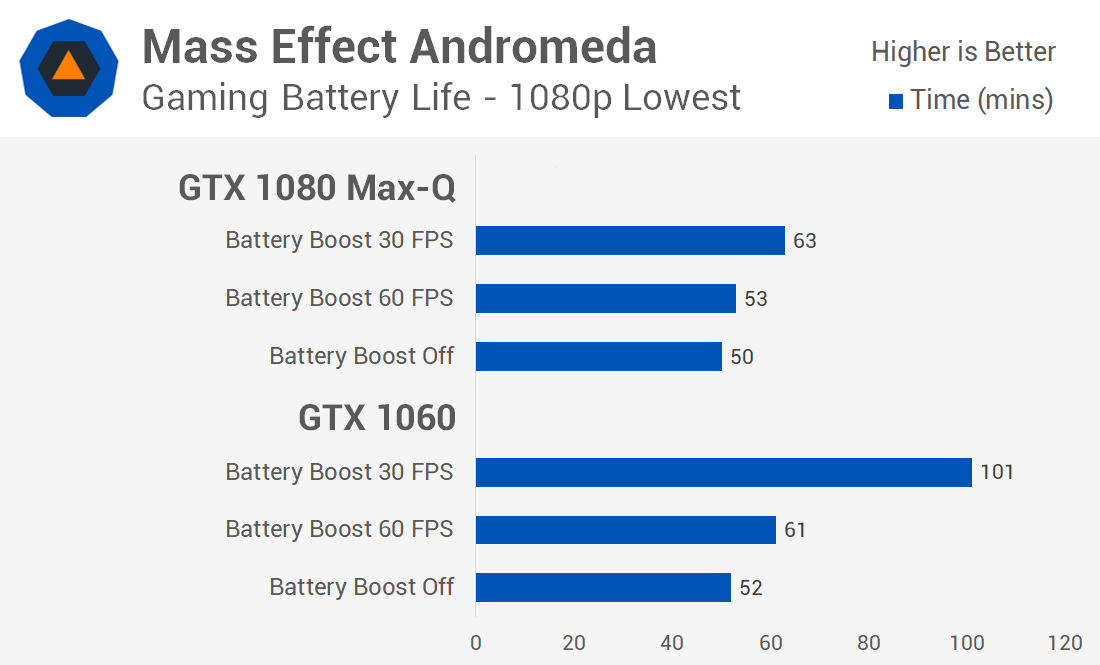
The first game I tested with was Mass Effect Andromeda, because it scales down nicely and allows you to achieve more than 60 FPS on the lowest settings on battery with these systems. This gives us a good idea of how Nvidia's Battery Boost technology works to enhance the battery life of these systems.
With the GTX 1060 system running at full performance, I achieved 52 minutes of gaming, which is short though not unexpected for a gaming system. Here the game runs at around 100 FPS in the area I tested with and at the lowest settings at 1080p. Capping the game to 60 FPS using Battery Boost didn't have a massive effect, increasing play time by just 9 minutes for a 17% gain. However, the real gains are seen in capping the game to 30 FPS; now the laptop lasted just shy of twice as long, which is a huge gain. Of course, you will have to put up with a console-like experience at low detail levels, and even then you won't get 2 hours of life here, but it does show the advantage of Battery Boost.
On the other hand, the GTX 1080 Max-Q model isn't as affected by Battery Boost. It achieved around the same gameplay duration with Battery Boost disabled, at a slightly higher level of performance, however capping the game to 60 FPS only increased the battery life by 6 percent, and capping to 30 FPS led to just a 26 percent increase. Going from 100+ FPS to 30 FPS for just 13 minutes more gameplay in this situation isn't ideal.
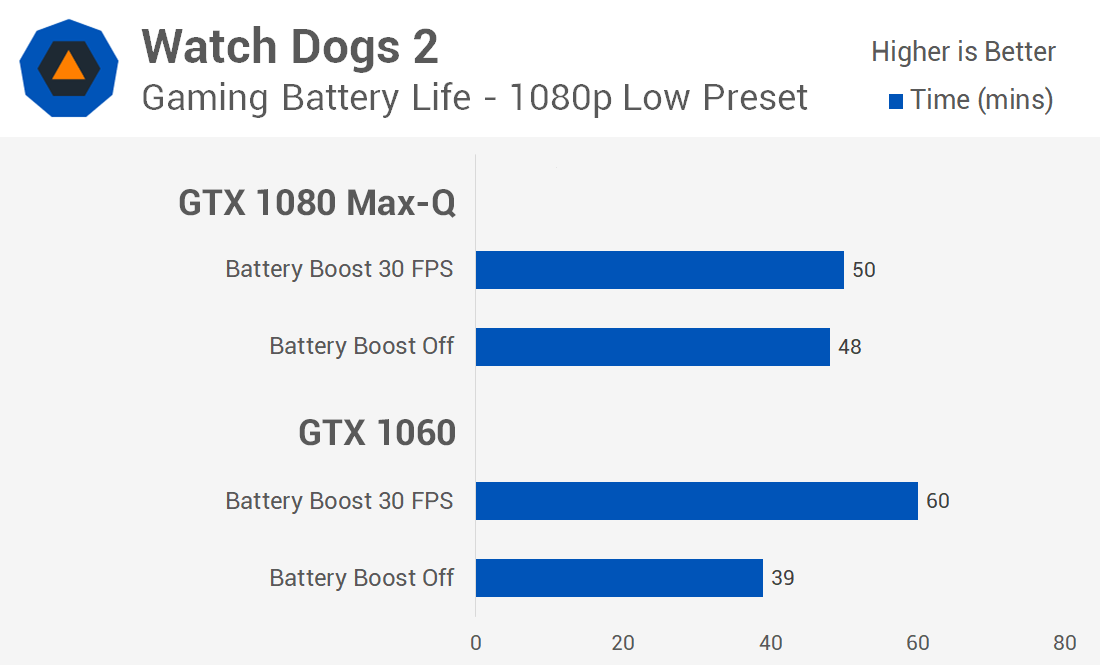
It's a similar story with Watch Dogs 2. Here the game set to 1080p and the low preset, achieved around 42 FPS in the test area on both systems, and it was surprising to discover the GTX 1080 Max-Q model lasted a good 9 minutes, or 23 percent longer. However when capped to 30 FPS, it's the GTX 1060 that outperformed the GTX 1080 Max-Q by 20 percent, using its efficiency when underutilized to just hit the 60 minute mark. The GTX 1080 Max-Q barely improved in stamina when Battery Boost was activated to reduce performance by 27 percent.
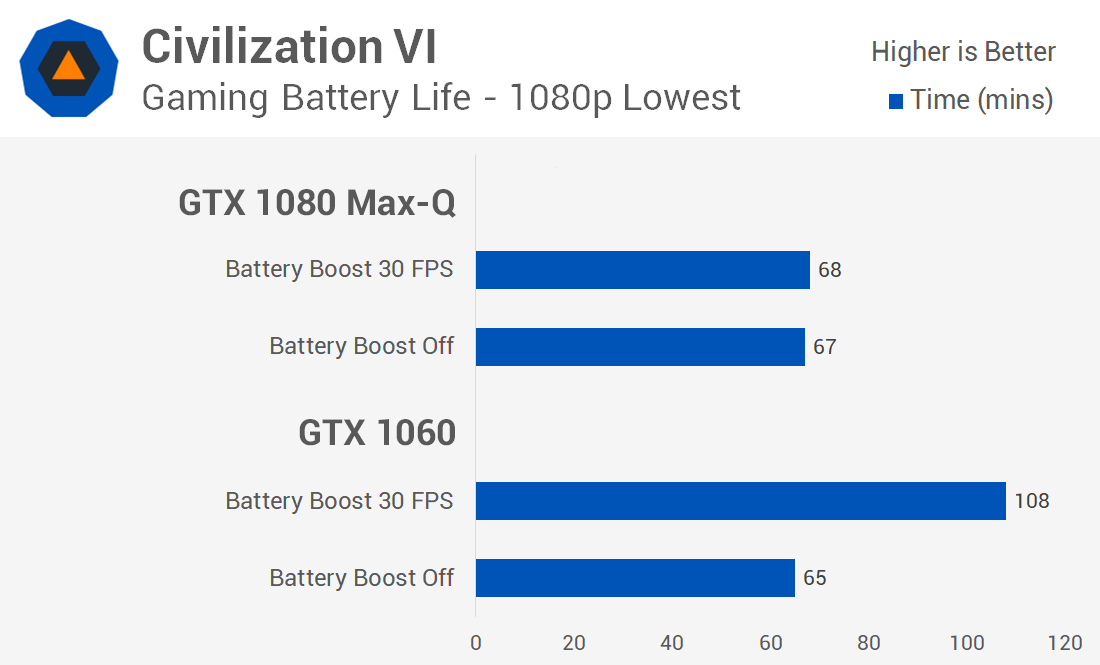
The final game I tested with is Civilization VI, which like a lot of strategy games is great for playing on the go. With the performance uncapped, the GTX 1060 model hovered around 45 FPS in a late-game save with everything at the lowest detail level. Surprisingly it managed to last 65 minutes at this performance, and incredibly, capping the game to 30 FPS boosted this result to 108 minutes. In other words, a 33 percent reduction in frame rate led to a 66 percent increase in stamina, which is excellent from this system. And Civilization VI is very playable at a locked 30 FPS.
Civilization VI also lasts longer than normal with the GTX 1080 Max-Q, but it's again a title where Battery Boost's 30 FPS cap has no significant impact on battery life.
In general, these battery life figures are quite low, and that's a product of the mere 50 Wh battery inside the Triton 700. Many other larger and heftier gaming laptops feature larger batteries, in the 75 to 100 Wh range, and those typically last between 1 and 3 hours in games. Yeah, that's still not ages, but it's a little better than these numbers.
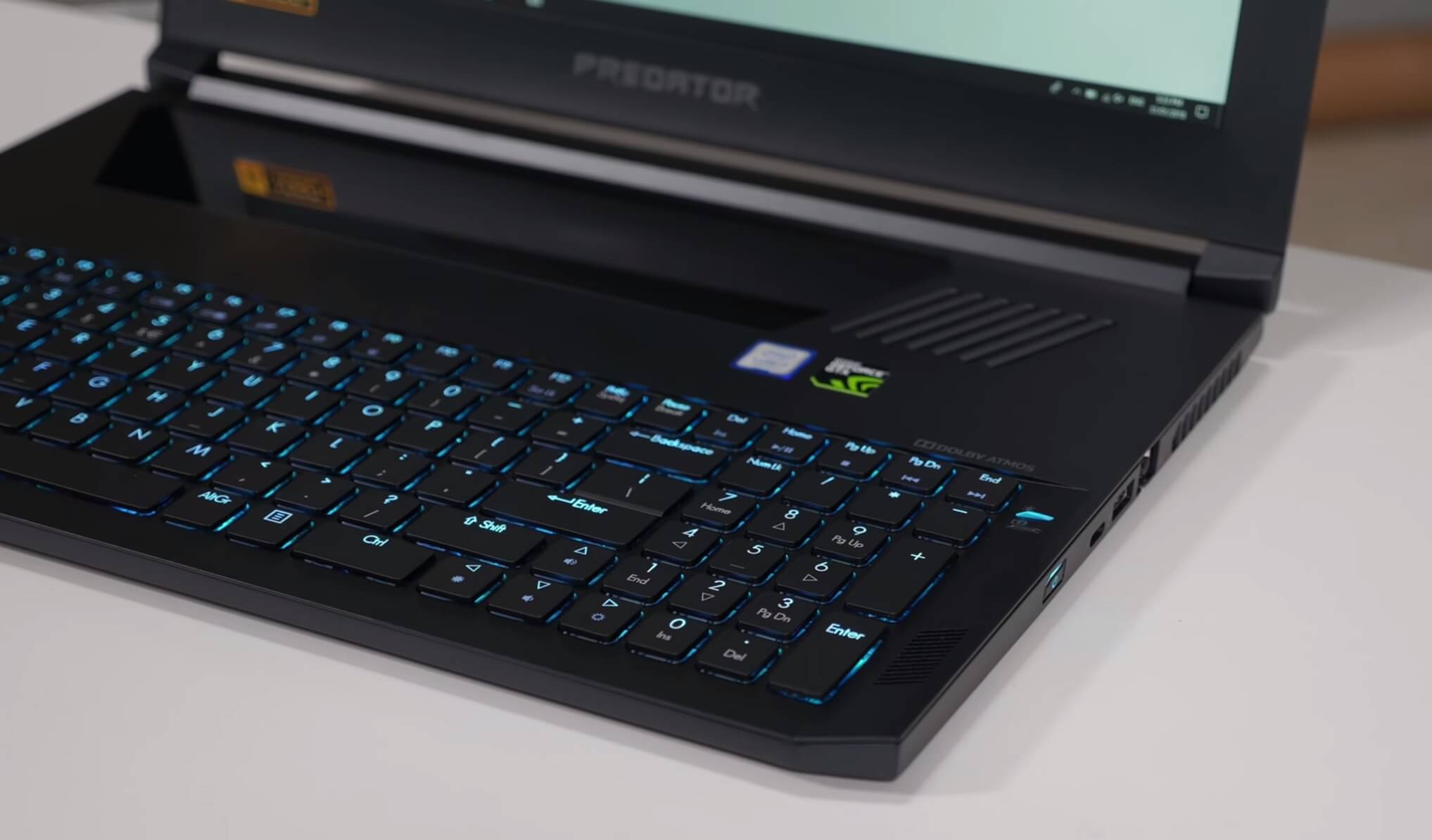
I will say, though, that if you are planning on utilizing Battery Boost you should also enable V-Sync, as for some reason you get nasty tearing in some games with V-Sync disabled and Nvidia capping the frame rate to 30 FPS.
If you're thinking of buying a gaming laptop and want to play games away from the power outlet, based on these tests I'd recommend a few things: 1) pick and choose the game carefully, something closer to a eSports title that doesn't rely so heavily on sheer GPU power will do better, 2) don't get something too powerful, as you won't be harnessing the extra power and it likely won't last as long compared to a less powerful system.
The GTX 1060 provides a decent mix of plugged-in power and battery stamina when capped to 30 FPS, though if you want to do a lot of gaming on battery, something like a GTX 1050 or 1050 Ti could be a better option. No matter the situation though, don't expect to get a lot of performance out of a system running on battery power.
 China just built the world's biggest floating solar project
China just built the world's biggest floating solar project
 Why it's totally possible this group of hackers is the CIA
Why it's totally possible this group of hackers is the CIA
 We became scientists to help the world. Now we need to take to the streets.
We became scientists to help the world. Now we need to take to the streets.
 'Fear Factor' reboot hosted by Ludacris is coming whether you like it or not
'Fear Factor' reboot hosted by Ludacris is coming whether you like it or not
 Here's a helpful* video on how to defend yourself with jiu
Here's a helpful* video on how to defend yourself with jiu
 George R.R. Martin is just tryin' to hang with the cool kids
George R.R. Martin is just tryin' to hang with the cool kids
 Model shares photo of her cellulite on Instagram to show 'how bloody natural it is'
Model shares photo of her cellulite on Instagram to show 'how bloody natural it is'
 Wordle today: The answer and hints for January 28, 2025
Wordle today: The answer and hints for January 28, 2025
 Gaming journalist heroically stops attacker, but may never fully recover from slashing
Gaming journalist heroically stops attacker, but may never fully recover from slashing
 We'll always, er, sorta, have the Paris Climate Agreement
We'll always, er, sorta, have the Paris Climate Agreement
 Model shares photo of her cellulite on Instagram to show 'how bloody natural it is'
Model shares photo of her cellulite on Instagram to show 'how bloody natural it is'
 Ancient Greeks and Aboriginal Australians saw constellations in common
Ancient Greeks and Aboriginal Australians saw constellations in common
 Now you can rant about 'Game of Thrones' with this new tweetstorm app
Now you can rant about 'Game of Thrones' with this new tweetstorm app
 In Paris Agreement speech, Trump never acknowledged the reality of global warming
In Paris Agreement speech, Trump never acknowledged the reality of global warming
 Stop it with all the random 'National Day' hashtags already
Stop it with all the random 'National Day' hashtags already
 'Fawlty Towers' fans, rejoice: John Cleese is returning to the BBC for a new sitcom
'Fawlty Towers' fans, rejoice: John Cleese is returning to the BBC for a new sitcom
 Why it's totally possible this group of hackers is the CIA
Why it's totally possible this group of hackers is the CIA
 Best Presidents' Day deal: Save $44 on Fitbit Charge 6
Best Presidents' Day deal: Save $44 on Fitbit Charge 6
 Court rules to shut down a mobile tower after a man alleges he got cancer from it
Court rules to shut down a mobile tower after a man alleges he got cancer from it
What is systemic racism?Devin Nunes can't sue Twitter over a parodyChina now has a one13 hilariously viral moments from the UK election campaign 2017Google Phone app gets feature to let you know WHY a business is callingGet your general election facts — the REAL facts — right hereKendall Jenner with a fidget spinner is a walking metaphor for 2017Lit AF peacock gets away with breaking $500 worth of liquorSurprise, surprise: Betsy DeVos will not commit to protecting LGBTQ students from discriminationWe want your honest loyalty about these posters we designed for 'TrumpBlack Power activist Olive Morris celebrated in Google DoodleTop Twitch streamer Dr. Disrespect was mysteriously bannedTwitter admits it went too far with '5G causes COVIDTwitter admits it went too far with '5G causes COVID'The Twilight Zone' Season 2 brings twists with a deep cut throwbackBlack Power activist Olive Morris celebrated in Google DoodleTLC confirms that their zero tolerance policy for scrubs remains firmWhat is systemic racism?Family throws elaborate quinceañera for their 15Students rant about ridiculously confusing exam with hilarious memes Samsung confirms Unpacked stream for July 9 The biodegradable paper airplane that could revolutionize humanitarian aid Warriors learn once again that being the best team means the memes are coming Another Trump diss gets some beautiful merch Crazy storm has streets of L.A. swallowing cars whole MashTalk: Should Apple be required to provide instructions on how to fix your iPhone? This wearable can turn your dance moves into music Someone uncovered an old email that predicted Donald Trump's presidency Elderly woman finds £5 note worth £50,000, donates the money to young people The US wants to check Chinese visitors' social media profiles 'Logan' is the most important X Apple has reportedly bought the Israeli tech firm RealFace Bill Maher doesn't understand how Milo Yiannopoulos works Samsung's turmoil derails plan to crown its heir apparent Ridiculous plan to remove a rat from a house actually works Sir David Attenborough is back and 2017 is finally starting to look up Please enjoy the many faces of Beyoncé, Jay Z and Blue Ivy at the NBA All Donald Glover will be the new Simba, but Mufasa will be a familiar face The geekiest signs from the 'Stand up for Science' rally Guy sets new world record for most finger snaps in a minute
3.2903s , 10265.140625 kb
Copyright © 2025 Powered by 【homo eroticism aquaman】,Wisdom Convergence Information Network